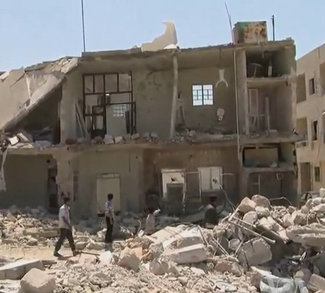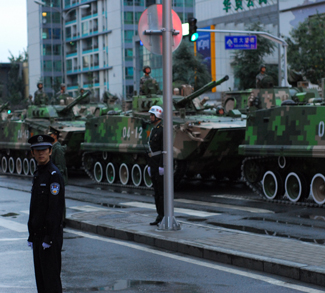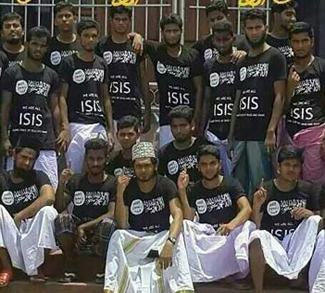As Assad was losing ground from 2011 to October 2013, Iran became heavily involved in maintaining the current regime in power. As per its national military strategy, and restrained by its limited high-end conventional capabilities, Tehran is projecting force into Syria by training, arming, and advising local and foreign Shia militias which act as light-infantry forces. Iran also provides them with small arms and a few stand-off capabilities like rockets and anti-tank missiles. Those militias are meant to supplement the Syrian Arab Army (SAA), which is suffering from a chronic lack of manpower as a result of years of attrition and desertions. Indeed, it’s necessary to keep in mind that the lack of manpower is a constant constraint that impacts Iran’s theater-level and operational-level strategic planning.
Regarding the theater strategic level, the lack of manpower impedes the regime from reconquering the entire country, therefore forcing Tehran and the Alawite regime to focus their war effort on establishing full government control over the Aleppo-Homs-Damascus corridor, where 60% of the national population lives, thus reinforcing Assad’s position significantly both on the battlefield and on the diplomatic front.
In order to achieve this theater-level strategic objective of fully controlling the corridor, Iran’s main operational objective is the complete recapture of Aleppo given that it’s Syria’s most populous city, and it has been partially occupied by the rebellion since 2011. However, since lack of manpower is a constant constraint, Iran devised an operational strategy aimed at managing the limited manpower via prioritization of fronts. Regarding the defense of government-held areas within the corridor, Iran organized low-labor intensive defensive lines thus enabling a labor-intensive offensive campaign against Aleppo. Concretely, the defense of regime-held areas falls to Iranian-backed lightly armed local militias which are supported by a residual SAA garrison that provides fire support to the irregular infantry force with a handful of artillery assets. Therefore, this enables the bulk of SAA troops alongside foreign Iranian-backed Shia militias to participate in the offensive campaign against rebels in Aleppo.
However, the offensive component of the Iranian strategy was a failure since the SAA, supplemented by foreign Shia militias, failed to achieve the main operational objective of capturing Aleppo. This happened due to the conducting of offensive ops through supporting arms – aimed at hitting the enemy with two or more arms sequentially – instead of a combined arms approach characterized by hitting the adversary with two or more arms simultaneously, thus pushing him to defend against one while being vulnerable to another arm. Indeed, due to the chronic lack of manpower, the SAA opted for an economy of force strategy epitomized by an improvised supporting arms method where each ground offensive against an opposition-held population center is preceded by indiscriminate artillery barrages and/or airstrikes aimed at softening the rebels as well as forcing civilians to flee the area therefore theoretically leaving only the softened opposition forces in the vicinity, thus theoretically facilitating the ground forces’ job of clearing the rebel area without heavy casualties in the absence of continuous air and artillery support. Moreover, despite the fact that the SAA initially possessed a Soviet/Russian combined arms doctrine, it couldn’t provide fire support at danger close distances to the ground forces for fear of friendly fire. This is due to the lack of modern fire control and combat management systems for their artillery as well as the absence of target acquisition hardware and precision guided-munitions for their fixed-wing aircrafts. Moreover, Iran had no choice but to rely on the SAA’s supporting arms ops since it couldn’t provide the Syrian state with high-end military capabilities that would’ve permitted the execution of combined arms ops due to the fact that Tehran has been under an arms embargo since 1979. Consequently, instead of capturing Aleppo in the space of a few months, the unsupported clearing ops became year-long protracted urban battles that not only increased loyalist losses but also gave the rebels time to regroup and mount successful counter-offensives that stopped the regime’s encirclement of the city.
Indeed, the lack of manpower plaguing Assad’s forces meant that a labor-intensive maneuver op like the encirclement of Aleppo was bound to create over-extended lines. Consequently, rebels were able to mass enough forces in a few spots to overwhelm the defenses of the regime offensive’s outer perimeter line. Furthermore, the regime’s over-extended lines were even more vulnerable to a rebel counter-offensive since there was little to no artillery and air cover due to friendly fire concerns.
Concerning this chronic lack of manpower, although the renewed push in Aleppo overextends the regime’s lines, the risk of a successful rebel counter-offensive is diminished unlike in the case of the year-long Iranian offensive.
Moreover, it’s worth noting that sometimes the Assad regime doesn’t even employ indiscriminate artillery and air strikes in a supporting arms fashion, but uses them without any follow-up ground clearing ops in rebel-held areas. Indeed, since the shortages in manpower are so acute, the Alawite-led regime devised an anti-access/area denial (A2/AD) strategy that enables it to prevent the armed opposition from effectively controlling areas where no loyalist ground troops are available. As a matter of fact, the loyalists conduct indiscriminate artillery barrages and airstrikes against certain rebel-held population centers as a form of collective punishment without committing ground forces tasked with liberating and holding the area. As a result, cut off from any supplies in addition to being pounded by the regime’s air force and artillery, the civilians blame the armed opposition for their plight and pressure them to stay away from their towns. Furthermore, those punitive strikes also force the non-combatants to evacuate towards government-controlled zones where daily artillery and airstrikes don’t occur, thus permitting a more or less normal life.
That being said, the defensive component of the Iranian theater-level military strategy proved to be more successful. The pro-Assad camp managed to hold the line on the majority of government-held areas thanks to the transition from a Russian doctrine to the Iranian ‘Mosaic’ doctrine bent on protracted defense. First of all, the Mosaic doctrine privileges decentralized command and control providing the local commander greater initiative in defending his area. Secondly, regarding the force structure, the Iranian doctrine emphasizes the integration of irregular and conventional forces as well as the different combat arms in one unit responsible for the defense of a particular area hence the term mosaic. Therefore, since the different combat arms are under one localized command, the local commander is better able to repel a rebel offensive given that the few regular SAA artillery assets in his area are under his direct command thus enabling him to direct fire support more efficiently for the local irregular infantrymen. Furthermore, the relative success of the defensive component of Iran’s theater-level strategy in Syria comes down to the fact that the artillery is used as a point-defense weapon lying close to the line of contact between rebels and the irregular infantry, therefore decreasing the risk of friendly fire. Indeed, the short ranges enable artillery assets to support troops with greater precision.
As a result of all of this, the period between October 2013 and November 2014 was marked by a stalemate where no side was able to gain a decisive advantage on the other. However, it’s worth keeping in mind that the regime’s success in repelling rebel offensives against loyalist areas within the corridor isn’t just the result of the Mosaic doctrine’s application, but also the fractured nature of the armed opposition impeding them on coordinating attacks against government holdouts within the corridor.
This situation began to change by November 2014 when the different rebel groups agreed to coordinate their offensives in exchange for increased arms shipments from their foreign backers. Consequently, the armed opposition was able to exert significant pressure on specific spots of the regime’s defensive lines, thus overwhelming the local militias and the residual SAA presence there and creating the opportunity for a breakthrough. The defensive component of the Iranian theater-level strategy began to unravel since it wasn’t designed to withstand concerted and concentrated rebel offensives. As a result, from November to September 2015, the opposition progressed dangerously close towards the Alawite heartland of Latakia and the capital Damascus. Realizing that the Iranian war effort failed, Putin was faced with the prospect of losing its last state ally in the Middle East. Consequently, on September 30th 2015, Russia intervened militarily in Syria; the first time the Kremlin conducted major combat operations outside its Near Abroad since the Soviet-Afghan war.
Russia Enters the Fray
In its effort to stave off the Assad regime’s collapse, Russia intervened directly starting September 2015. Since Russia possesses far greater conventional military capabilities than Iran, the Kremlin’s national military strategy’s is composed of air and artillery support for the regime’s forces. However, just like Iran, Russia also has to take into account the chronic lack of manpower in its theater-level and operational-level strategic planning.
Indeed, because of this shortage of manpower, Russia adopted Tehran’s theater-level strategy of focusing the war effort on achieving full control of the Aleppo-Homs-Damascus corridor and therefore bolstering Assad’s international image as the uncontested ruler of Syria since the majority of the population would be living under him.
To achieve the theater-level strategic objective of fully controlling the corridor, just like Iran, the Kremlin’s main operational objective is the total recapture of Syria’s most populous city Aleppo which has been under partial rebel control since 2011 despite a failed Iranian-backed campaign in 2014. Furthermore, in order to liberate this population center, Russia has also appropriated Iran’s operational strategy aimed at managing the limited manpower by prioritizing certain fronts through the organization of a low-labor intensity defense of government-held areas within the corridor thus enabling a labor-intensive offensive campaign against Aleppo. Concretely, the defense of regime-held areas falls to Iranian-backed lightly armed local militias which are supported by a residual SAA garrison that provides fire support to the irregular infantry force with a handful of artillery assets. Therefore, this enables the bulk of SAA troops and Iranian-backed foreign Shia militias to participate in the offensive campaign against rebels in Aleppo with Russian air and artillery cover.
Thanks to Russia’s direct military intervention, the renewed push to capture Aleppo proved to be more successful than Iran’s attempt despite the fact that the complete encirclement of opposition areas in the city is still incomplete. Indeed, instead of taking a full year to coming close to severing the Castello Road, which is the last rebel supply route out of the city, the new offensive with Russian support just took a few months to sever the Castello Road. This relatively speedy success stems from the fact that Moscow reinstated the combined arms method thanks to the high-end conventional military capabilities it brings on the battlefield. Therefore, Iranian-backed Shia foreign militias and SAA ground forces now benefit from artillery and air cover while advancing to clear enemy presence. Furthermore, keeping in mind that Russia lacks the quantitative edge in air-delivered precision-guided munitions possessed by Western countries, air and artillery support complement themselves more in the Russian doctrine than in Western doctrines in order to minimize fratricide in combined arms ops. As a result, fixed-wing aircrafts armed with unguided bombs such as the SU-24 Fencer operate farther away from the line of contact between opposing forces in order to minimize friendly fire. Indeed, they are tasked with deep air support aimed at engaging enemy targets located farther away from the frontline in order to disrupt or hinder future enemy engagement of friendly forces. As for danger-close fire support, rotary-wing aircrafts like the MI-35 Hind, are used for close air support due to their slow speed and loitering capabilities. In addition to attack helicopters, artillery is once again employed on Syrian battlefields for danger close fire support thanks to the provision of modern combat management systems enabling coordination with ground forces as well as modern fire control systems permitting precision targeting. Moreover, the resumption of artillery use in the context of combined arms ops isn’t only due to the acquisition of new technologies but also to organizational changes. As a matter of fact, Russia is applying the lessons of the 2nd Chechen War in Syria by making sure that SAA regular forces engaged in urban battles are divided into joint units called storm groups combining infantry, armor and more importantly artillery. Consequently, the storm group’s overall combined arms officer has direct command over artillery therefore enabling him to use it more efficiently in helping infantry and armored units tasked with clearing ops. Indeed, in this organizational configuration, artillery can be used in indirect and direct fire mode to clear dug in rebels in an urban environment.
That said, the reinstatement of combined arms ops doesn’t mean that the supporting arms approach has been discarded. On the contrary, both are complimentary. Indeed, the renewed push for Aleppo has two phases. The first phase is marked by a supporting arms mode where heavy caliber tube and rocket artillery as well as air power are used indiscriminately to force the civilian population out of opposition-held areas thus leaving mostly softened rebels. The second phase consists of combined arms clearing ops led by the joint storm groups where smaller caliber tube artillery pieces increase the ground force’s firepower in an urban environment through indirect and direct fire support at danger close distances.
Furthermore, this complementarity between supporting arms and combined arms doesn’t mean the end of indiscriminate artillery barrages and airstrikes in an A2/AD mode where no ground troops are required to clear and hold a population center. The fact of the matter is that Russia alongside the regular loyalist forces continue this practice of bombing indiscriminately with no subsequent ground offensives due to persistent shortages in manpower.
Concerning this chronic lack of manpower, although the renewed push in Aleppo overextends the regime’s lines, the risk of a successful rebel counter-offensive is diminished unlike in the case of the year-long Iranian offensive. Indeed, the regime’s overextended outer defensive lines in Aleppo benefit from air and artillery cover since the risk of friendly fire is diminished. Therefore, it’s fair to say that the presence of high-end Russian conventional military capabilities partially offsets the lack of manpower. However, since it’s partial, the regime’s outer defensive lines can still be submerged by a massive rebel counter-attack that can overwhelm artillery and air support. That’s what happened two weeks ago when the opposition withdrew forces from other fronts to reallocate them to Aleppo in order to break the siege following the closing of the Castello Road. As a result, the rebels have a new supply route to supply their beleaguered forces in the city. In turn, this setback pushed Assad and Iran to also reallocate more ground forces to the Aleppo front and might as well force Russia to dispatch additional air and artillery assets to this specific area thus proving the adage that quantity has a quality of its own despite the promises that increased firepower can offset the inherent limitations of a numerically limited ground force.
As for the defensive component of the theater-level strategy, Moscow mostly leaves the low-labor intensive defense of government-held areas to Iran who continues to employ a mix of irregular and residual regular forces within the framework of its Mosaic doctrine despite its past failure to contain concerted rebel offensives between late 2014 and mid-2015. This is due to the fact that the risk of those defensive lines being submerged is low given that the danger of coordinated rebel attacks has faded since the opposition has reallocated a significant chunk of its forces to the Aleppo front.
Furthermore, the fact that both the foreign-backed opposition and Assad regime contribute a lot of forces to Aleppo is because it’s the commercial capital and the most populous city in Syria. Therefore, its complete capture will bolster one’s claim that it rules over the majority of the population. Second, due to its close proximity to the Turkish border and its populous nature, Aleppo is the main hub for delivering supplies to the armed opposition in northwestern Syria. Consequently, its capture by Assad and his Russian and Iranian allies will significantly weaken the rebels in the area. Moreover, since Aleppo is the last bastion of the moderate rebels in northwestern Syria, their destruction will reinforce the regime’s narrative that it’s fighting against Jihadist groups. As a result, the battle for Aleppo will be a long drawn contest.




